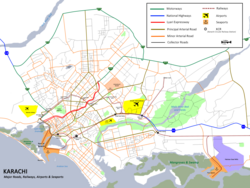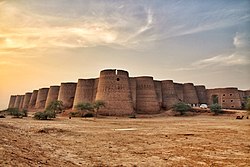| Manora Fort | |
|---|---|
| Part of Manora Cantonment | |
| Manora, Karachi, Pakistan | |
 Manora Fort was captured by the British in 1839, and then reinforced in 1888 | |
| Site information | |
| Type | Fort |
| Controlled by | Pakistan Navy |
| Location | |
 | |
| Coordinates | 24°47′24″N66°58′46″E / 24.79000°N 66.97944°E |
| Site history | |
| Built | 1797 |
| Materials | mud fortress (original) |
Manora Fort is a fort that was built to protect the harbour of Karachi. [1] Originally erected as a mud fortress by the Talpur Mirs in 1797, the fort was captured by the British in 1839 - after which they seized control of Karachi and lower Sindh. [2]



